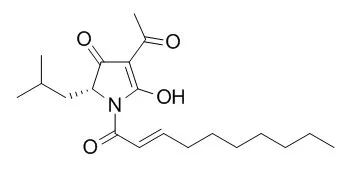| Food Microbiol. 2013 May;34(1):46-51. |
| Effects of nisin and reutericyclin on resistance of endospores of Clostridium spp. to heat and high pressure.[Pubmed: 23498177] |
The effects of high pressure, temperature, and antimicrobial compounds on endospores of Clostridium spp. were examined.
METHODS AND RESULTS:
Minimal inhibitory concentrations (MIC) of nisin and Reutericyclin were determined for vegetative cells and endospores of Clostridium sporogenes ATCC 7955, Clostridium beijerinckii ATCC 8260, and Clostridium difficile 3195. Endospores of C. sporogenes ATCC 7955 and C. beijerinckii ATCC 8260 were exposed to 90 °C and 90 °C/600 MPa in the presence of 16 mg L(-1) nisin or 6.4 mg L(-1) Reutericyclin for 0-60 min in a 0.9% saline solution. Dipicolinic acid (DPA) release was measured using a terbium-DPA fluorescence assay, and endospore permeability was assessed using 4',6-diamidino-2-phenylindole (DAPI) fluorescence. Vegetative cells of C. sporogenes ATCC 7955 exhibited higher sensitivity to nisin relative to endospores, with MIC values 0.23 ± 0.084 mg L(-1) and 1.11 ± 0.48 mg L(-1), respectively. Nisin increased DPA release when endospores were treated at 90 °C; however, only C. sporogenes ATCC 7955 exhibited higher inactivation, suggesting strain or species specific effects.
METHODS AND RESULTS:
Reutericyclin did not enhance spore inactivation or DPA release. Use of nisin in combination with high pressure, thermal treatments enhanced inactivation of endospores of Clostridium spp. and may have application in foods. |
| Sci Rep. 2014 Apr 17;4:4721. |
| Chemical modulation of the biological activity of reutericyclin: a membrane-active antibiotic from Lactobacillus reuteri.[Pubmed: 24739957] |
METHODS AND RESULTS:
Whilst the development of membrane-active antibiotics is now an attractive therapeutic concept, progress in this area is disadvantaged by poor knowledge of the structure-activity relationship (SAR) required for optimizing molecules to selectively target bacteria.
This prompted us to explore the SAR of the Lactobacillus reuteri membrane-active antibiotic Reutericyclin, modifying three key positions about its tetramic acid core. The SAR revealed that lipophilic analogs were generally more active against Gram-positive pathogens, but introduction of polar and charged substituents diminished their activity. This was confirmed by cytometric assays showing that inactive compounds failed to dissipate the membrane potential. Radiolabeled substrate assays indicated that dissipation of the membrane potential by active Reutericyclins correlated with inhibition of macromolecular synthesis in cells. However, compounds with good antibacterial activities also showed cytotoxicity against Vero cells and hemolytic activity.
CONCLUSIONS:
Although this study highlights the challenge of optimizing membrane-active antibiotics, it shows that by increasing antibacterial potency the selectivity index could be widened, allowing use of lower non-cytotoxic doses. |
| Appl Environ Microbiol. 2013 Mar;79(6):2103-6. |
| In situ determination of Clostridium endospore membrane fluidity during pressure-assisted thermal processing in combination with nisin or reutericyclin.[Pubmed: 23335780] |
METHODS AND RESULTS:
This study determined the membrane fluidity of clostridial endospores during treatment with heat and pressure with nisin or Reutericyclin. Heating (90°C) reduced laurdan (6-dodecanoyl-2-dimethylaminonaphthalene) general polarization, corresponding to membrane fluidization. Pressure (200 MPa) stabilized membrane order.
CONCLUSIONS:
Reutericyclin and nisin exhibit divergent effects on heat- and pressure-induced spore inactivation and membrane fluidity. |






 Cell. 2018 Jan 11;172(1-2):249-261.e12. doi: 10.1016/j.cell.2017.12.019.IF=36.216(2019)
Cell. 2018 Jan 11;172(1-2):249-261.e12. doi: 10.1016/j.cell.2017.12.019.IF=36.216(2019) Cell Metab. 2020 Mar 3;31(3):534-548.e5. doi: 10.1016/j.cmet.2020.01.002.IF=22.415(2019)
Cell Metab. 2020 Mar 3;31(3):534-548.e5. doi: 10.1016/j.cmet.2020.01.002.IF=22.415(2019) Mol Cell. 2017 Nov 16;68(4):673-685.e6. doi: 10.1016/j.molcel.2017.10.022.IF=14.548(2019)
Mol Cell. 2017 Nov 16;68(4):673-685.e6. doi: 10.1016/j.molcel.2017.10.022.IF=14.548(2019)